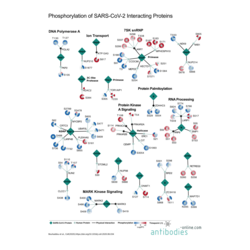The Global Phosphorylation Landscape of SARS-CoV-2 Infection
Severe acute respiratory syndrome coronavirus 2 (SARS-CoV-2) belongs to the enveloped positive-sense RNA viruses. The Phosphorylation Landscape of SARS-CoV-2 Infection presented here is a step towards a deeper understanding of virus-host relationship and vaccine development.1
During a COVID-19 infection both, host and viral proteins, undergo major changes in phosphorylation. The virus tries to alter activities of e.g. kinases in order to influence cellular signaling to its benefits. The map on the left is based on the SARS-CoV-2 virus-host protein-protein interaction map of Gordon et al.2 and shows 40 human proteins which are significantly differentially phosphorylated across infection at least two time points. Viral proteins are shown as green diamonds. Interacting human proteins are shown as gray or respectively dark grey circles . PHs emanate from human proteins, colored by change compared with uninfected control samples (red, increase; blue, decrease) at each time point (0, 2, 4, 8, 12, and 24 h after infection) in a clockwise fashion.
The SARS-CoV-2 N protein is known to interact with several RNA-processing proteins that are differentially phosphorylated during infection, including LARP1 and RRP9. Here LARP1 phosphorylation decreases on several sites, which is known to consequently increase LARP1 affinity for 3' untranslated regions (UTRs) of mRNAs encoding ribosomal proteins, driving inhibition of human protein synthesis.3 In addition, Nsp8 interacts with LARP7 and MEPCE which are important regulators of RNA polymerase II-mediated transcription elongation as part of the 7SK small nuclear ribonucleoprotein particle (snRNP) complex. Their phosphorylation may influence positive transcription elongation factor b (PTEFb [CDK9]) and transcriptional regulation of the virus.4
10 of the 40 interacting proteins are kinases, a decrease in activity for MARK2 and PRKACA were observed while CK2 shows increased activity. The changes in kinase activity offer insights into the biology of viral infection and possible attack points to fight an infection. Therefore kinases are predestined as drug targets and further research may lead to development of novel therapeutics relevant for future virus pandemics.
SARS-CoV-2 Structural Proteins: SARS-CoV-2 Spike Protein SARS-CoV-2 N Protein SARS-CoV-2 E Protein SARS-CoV-2 M Protein
All SARS-CoV-2 Non-Structural Proteins: SARS-CoV-2 Non-Structural Proteins
SARS-CoV-2 Antibodies: anti-SARS-CoV-2 Antibodies
References:
- : "A SARS-CoV-2 protein interaction map reveals targets for drug repurposing." in: Nature, Vol. 583, Issue 7816, pp. 459-468, (2020) (PubMed).
- : "The Global Phosphorylation Landscape of SARS-CoV-2 Infection. ..." in: Cell, Vol. 182, Issue 3, pp. 685-712.e19, (2020) (PubMed).
- : "LARP1 functions as a molecular switch for mTORC1-mediated translation of an essential class of mRNAs." in: eLife, Vol. 6, (2018) (PubMed).
- : "Phosphorylation of HEXIM1 at Tyr271 and Tyr274 Promotes Release of P-TEFb from the 7SK snRNP Complex and Enhances Proviral HIV Gene Expression." in: Proteomics, Vol. 15, Issue 12, pp. 2078-86, (2016) (PubMed).





